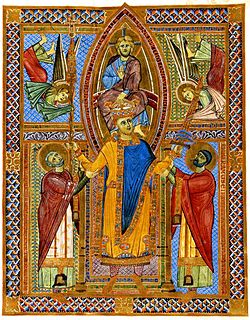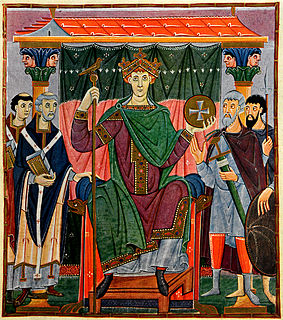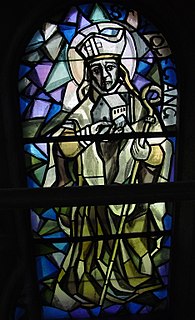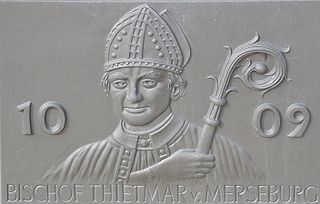Notes
Walthard (also Waltard, Walther) Born: c. 960 Died: 12 August 1012 on Giebichenstein Castle | ||
| Catholic Church titles | ||
|---|---|---|
| Preceded by Tagino | Archbishop of Magdeburg 1012 | Succeeded by Gero |
Walthard (or Waltaro) (died 12 August 1012) was the Archbishop of Magdeburg very briefly from June to August in 1012. [1]
Walthard was the initial archiepiscopal candidate of the cathedral chapter on the death of Archbishop Giseler in 1004, but King Henry II elected to appoint his chaplain Tagino instead. When Tagino died on 9 June 1012, the cathedral elected Walthard, but he died within a few months and they elected one named Otto, who was passed over again by the king in favour of Gero. [2] Otto was accepted into the royal chaplaincy as a consolation.
Walthard (also Waltard, Walther) Born: c. 960 Died: 12 August 1012 on Giebichenstein Castle | ||
| Catholic Church titles | ||
|---|---|---|
| Preceded by Tagino | Archbishop of Magdeburg 1012 | Succeeded by Gero |

Otto IV was one of two rival kings of Germany from 1198 on, sole king from 1208 on, and Holy Roman Emperor from 1209 until he was forced to abdicate in 1215. The only German king of the Welf dynasty, he incurred the wrath of Pope Innocent III and was excommunicated in 1210.
The 950s decade ran from January 1, 950, to December 31, 959.

Year 1002 (MII) was a common year starting on Thursday of the Julian calendar.

Otto III was Holy Roman Emperor from 996 until his early death in 1002. A member of the Ottonian dynasty, Otto III was the only son of the Emperor Otto II and his wife Theophanu.

Conrad II, also known as Conrad the Elder and Conrad the Salic, was Emperor of the Holy Roman Empire from 1027 until his death in 1039. The first of a succession of four Salian emperors, who reigned for one century until 1125, Conrad also served as King of Germany from 1024, King of Italy from 1026, and King of Burgundy (Arelat) from 1033.

The Archbishopric of Magdeburg was a Roman Catholic archdiocese (969–1552) and Prince-Archbishopric (1180–1680) of the Holy Roman Empire centered on the city of Magdeburg on the Elbe River.

Conrad I, called the Younger, was the king of East Francia from 911 to 918. He was the first king not of the Carolingian dynasty, the first to be elected by the nobility and the first to be anointed. He was chosen as the king by the rulers of the East Frankish stem duchies after the death of young king Louis the Child. Ethnically Frankish, prior to this election he had ruled the Duchy of Franconia from 906.

Saint Wolfgang of Regensburg was bishop of Regensburg in Bavaria from Christmas 972 until his death. He is a saint of the Roman Catholic and Eastern Orthodox churches. He is regarded as one of the three great German saints of the 10th century, the other two being Saint Ulrich of Augsburg and Saint Conrad of Constance. Towards the end of his life Wolfgang withdrew as a hermit to a solitary spot, in the Salzkammergut region of Upper Austria. Soon after Wolfgang's death many churches chose him as their patron saint, and various towns were named after him.

Thietmar, Prince-Bishop of Merseburg from 1009 until his death, was an important chronicler recording the reigns of German kings and Holy Roman Emperors of the Ottonian (Saxon) dynasty. Two of Thietmar's great-grandfathers, both referred to as Liuthar, were the Saxon nobles Lothar II, Count of Stade, and Lothar I, Count of Walbeck. They were both killed fighting the Slavs at the Battle of Lenzen.

Albert I of Käfernburg was Archbishop of Magdeburg from 1205 until his death.
Gebhard I, known as Gebhard of Swabia, was the Bishop of Regensburg from 994 until his death.
Tagino was the third Archbishop of Magdeburg from 1004 until his death.

Eckard I was Margrave of Meissen from 985 until his death. He was the first margrave of the Ekkehardinger family that ruled over Meissen until the extinction of the line in 1046.
Gisilher, Gisiler, Giseler, or Giselmar was the second Archbishop of Magdeburg, succeeding Saint Adalbert, from 981 until his death in 1004.
Dietrichof Haldensleben was a Saxon count in the Schwabengau, later also in the Nordthüringgau and the Derlingau, who was the first Margrave of the Northern March from 965 until the Great Slav Rising of 983. He also bore the title of a dux (duke) in contemporary sources.
Gero was the Archbishop of Magdeburg from 1012 until his death. He was a son of Dedo Wodenswege and Eilika (Eilica) and possibly a relative of the family of Gero the Great.
The Conradines or Conradiner were a dynasty of Franconian counts and dukes in the 8th to 11th Century, named after Duke Conrad the Elder and his son King Conrad I of Germany.

Otto I, traditionally known as Otto the Great, was German king from 936 and Holy Roman Emperor from 962 until his death in 973. He was the oldest son of Henry I the Fowler and Matilda.

Henry II, also known as Saint Henry the Exuberant, Obl. S. B., was Holy Roman Emperor from 1014. He died without an heir in 1024, and was the last ruler of the Ottonian line. As Duke of Bavaria, appointed in 995, Henry became King of the Romans following the sudden death of his second cousin, Emperor Otto III in 1002, was made King of Italy in 1004, and crowned emperor by Pope Benedict VIII in 1014.
Hartwig was the archbishop of Salzburg from 991 until his death. He was a younger son of the Bavarian count palatine Hartwig of the Aribonid family. The Gesta archiepiscoporum Salisburgensium calls him a "friend of divine praise".